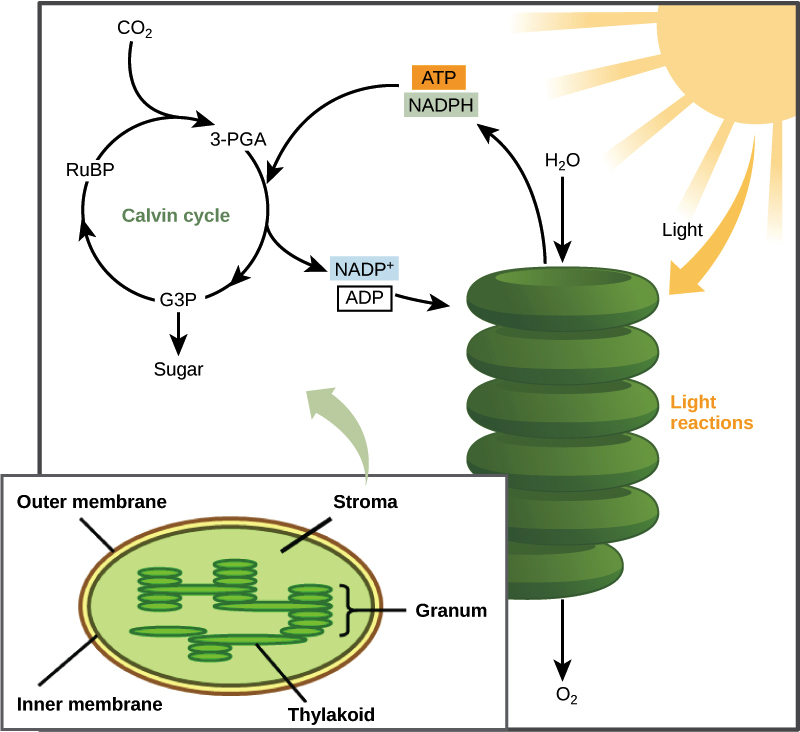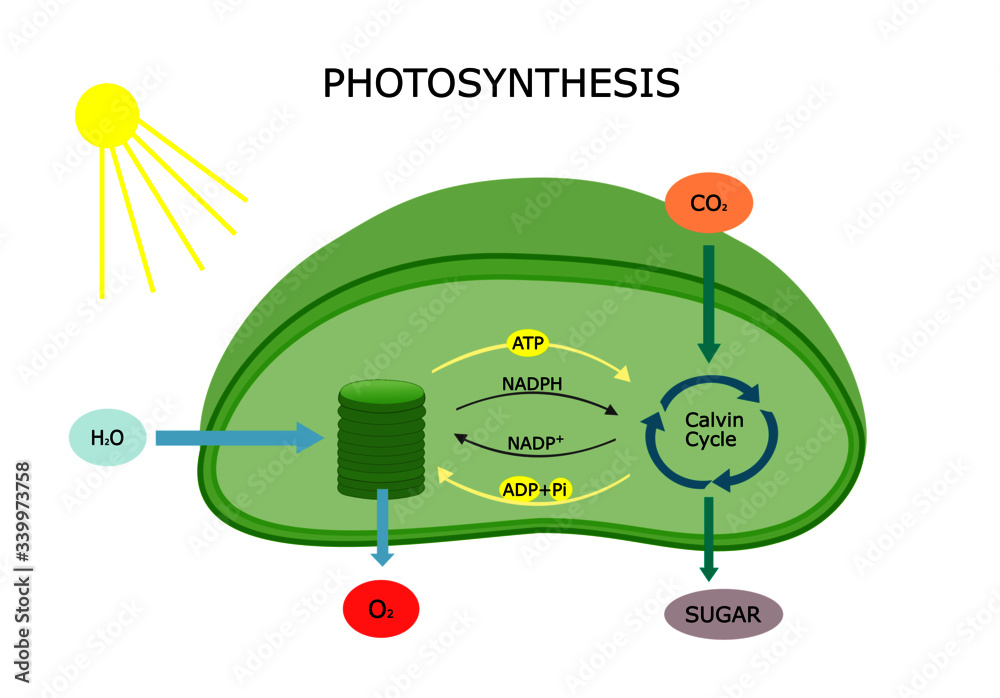Does calvin cycle happen in the stroma – Does the Calvin Cycle occur in the stroma? This question delves into the heart of photosynthesis, the process by which plants convert sunlight into energy. The Calvin cycle, a crucial part of this process, takes place within the chloroplasts, the green organelles found in plant cells. These chloroplasts are comprised of various compartments, each with its own unique role.
The stroma, a fluid-filled region surrounding the thylakoid membranes, plays a pivotal role in the Calvin cycle. It provides the necessary environment for the enzymes and molecules involved in converting carbon dioxide into sugars.
The Calvin cycle, also known as the light-independent reactions, is a series of biochemical reactions that use the energy captured during the light-dependent reactions to convert carbon dioxide into glucose. This process is essential for life on Earth, as it provides the foundation for the food chain and the production of oxygen.
The Calvin Cycle: The Foundation of Photosynthesis
The Calvin cycle is the cornerstone of photosynthesis, the process by which plants and other organisms convert light energy into chemical energy in the form of sugars. This cycle is a series of biochemical reactions that occur within the stroma, the fluid-filled space within chloroplasts, the organelles responsible for photosynthesis. The Calvin cycle plays a vital role in transforming inorganic carbon dioxide (CO 2) into organic sugars, providing the essential building blocks for life.
It’s like a factory that takes raw materials (CO 2) and converts them into valuable products (sugars) using the energy from sunlight captured by chlorophyll.
Chloroplast Structure and Compartments
Chloroplasts are the powerhouses of plant cells, and they have a unique structure that facilitates the process of photosynthesis.
- The chloroplast is enclosed by a double membrane, the outer membrane and the inner membrane. The space between these membranes is called the intermembrane space.
- Inside the inner membrane lies the stroma, a gel-like matrix that contains enzymes and other molecules essential for the Calvin cycle.
- Within the stroma are stacks of flattened, disc-shaped sacs called thylakoids. These thylakoids are arranged in stacks called grana, and they are the sites of the light-dependent reactions of photosynthesis.
- The thylakoid membrane encloses a space called the thylakoid lumen, which plays a role in the generation of ATP, a molecule that provides energy for cellular processes.
The Stroma and its Role: Does Calvin Cycle Happen In The Stroma

Imagine a chloroplast as a bustling factory, and the stroma is its main workshop. It’s a semi-fluid, gel-like substance that fills the space between the inner membrane and the thylakoid stacks. This space is crucial for the Calvin cycle, a series of chemical reactions that use energy from sunlight to convert carbon dioxide into sugars, the building blocks of life.
The Stroma’s Location and Key Features
The stroma is located within the chloroplast, specifically between the inner membrane and the thylakoid stacks. It’s a dynamic environment, constantly bustling with activity. It’s not just a simple, watery space; it’s filled with important components that make it the perfect location for the Calvin cycle.
The Stroma as the Site of the Calvin Cycle
The stroma is the heart of photosynthesis, serving as the site for the Calvin cycle. This cycle uses the energy stored in ATP and NADPH, generated during the light-dependent reactions, to fix carbon dioxide into sugars. Think of it as the assembly line where carbon dioxide is converted into usable energy for the plant.
Enzymes and Essential Molecules within the Stroma
The stroma is packed with enzymes and other essential molecules necessary for the Calvin cycle to function. These include:
- Rubisco: The star enzyme of the Calvin cycle, Rubisco catalyzes the first step of carbon fixation, the process of incorporating carbon dioxide into an organic molecule.
- Ribulose-1,5-bisphosphate carboxylase/oxygenase (RuBisCo): This enzyme is crucial for the first step of the Calvin cycle, where carbon dioxide is incorporated into an organic molecule.
- Other enzymes: The stroma contains a variety of other enzymes that catalyze the different steps of the Calvin cycle. These enzymes work together like a well-oiled machine to convert carbon dioxide into sugar.
- DNA: The stroma contains a small amount of DNA, which encodes for some of the proteins involved in photosynthesis.
- Ribosomes: The stroma also contains ribosomes, which are responsible for protein synthesis.
The stroma is a dynamic environment, constantly changing as the Calvin cycle proceeds. It’s a fascinating example of how a cell can create a specialized compartment to carry out a critical process.
Stages of the Calvin Cycle

The Calvin cycle, also known as the Calvin-Benson cycle, is a series of biochemical reactions that take place in the stroma of chloroplasts during photosynthesis. This cycle is responsible for converting carbon dioxide into sugar, which is the primary source of energy for most living organisms. The Calvin cycle can be broken down into three main stages: carbon fixation, reduction, and regeneration.
Carbon Fixation
Carbon fixation is the initial step in the Calvin cycle, where carbon dioxide from the atmosphere is incorporated into an organic molecule. This process is catalyzed by the enzyme Rubisco, which is considered one of the most abundant proteins on Earth. Rubisco combines carbon dioxide with a five-carbon sugar called ribulose-1,5-bisphosphate (RuBP), resulting in an unstable six-carbon intermediate that quickly breaks down into two molecules of 3-phosphoglycerate (3-PGA).
- RuBP + CO2 → (unstable six-carbon intermediate) → 2 molecules of 3-PGA
Reduction
The reduction stage involves the conversion of 3-PGA into glyceraldehyde-3-phosphate (G3P), a three-carbon sugar. This process requires energy from ATP and reducing power from NADPH, both of which are produced during the light-dependent reactions of photosynthesis. The energy from ATP is used to phosphorylate 3-PGA, while NADPH provides electrons to reduce the phosphorylated molecule.
- 3-PGA + ATP + NADPH → G3P + ADP + NADP+ + Pi
Regeneration
The regeneration stage involves the conversion of G3P back into RuBP, which allows the cycle to continue. This process requires energy from ATP and involves a series of complex enzymatic reactions. The regeneration stage is essential for maintaining the supply of RuBP, which is the starting molecule for carbon fixation.
- G3P + ATP → RuBP + ADP + Pi
Relationship Between the Calvin Cycle and the Light-Dependent Reactions
Think of photosynthesis as a two-part band. The light-dependent reactions are the energetic lead singer, pumping out the energy the Calvin cycle needs to do its thing. The Calvin cycle is the chill bassist, laying down the foundation for making sugar, which is the food for the plant. These two parts work together seamlessly, like a perfectly harmonized musical duo.
Energy Transfer From Light-Dependent Reactions to the Calvin Cycle
The light-dependent reactions capture light energy and use it to create ATP and NADPH, which are like the band’s power source and a musical instrument, respectively. These energy-rich molecules are then passed on to the Calvin cycle.
ATP and NADPH: The Powerhouse and the Musical Instrument, Does calvin cycle happen in the stroma
- ATP: This molecule is like the band’s powerhouse. It’s packed with energy, ready to be used by the Calvin cycle to power the process of making sugar. Think of it like the amplifier that gives the band’s sound that extra boost.
- NADPH: This molecule is like the musical instrument that helps the Calvin cycle create sugar. It carries electrons, which are essential for the chemical reactions in the Calvin cycle. It’s like the bass player, laying down the rhythmic foundation for the entire process.
Interconnectedness of the Calvin Cycle and Light-Dependent Reactions
The light-dependent reactions and the Calvin cycle are interconnected in a beautiful, symbiotic dance. The light-dependent reactions create the energy and reducing power that the Calvin cycle needs to function. The Calvin cycle then uses these products to create sugar, which is the plant’s food. Think of it as a continuous cycle, like a song that repeats and builds upon itself, with each part playing a vital role.
Factors Influencing the Calvin Cycle

The Calvin cycle, like any biological process, is sensitive to environmental conditions. Factors like light intensity, temperature, and carbon dioxide concentration can significantly influence the rate and efficiency of this crucial stage of photosynthesis.
Light Intensity
Light intensity directly affects the rate of the Calvin cycle. Higher light intensity provides more energy for the light-dependent reactions, which in turn produce more ATP and NADPH, the essential energy carriers for the Calvin cycle.
- At low light intensities, the Calvin cycle operates at a slower rate due to the limited supply of ATP and NADPH.
- As light intensity increases, the Calvin cycle speeds up, reaching a maximum rate at a certain point. Beyond this point, further increases in light intensity do not lead to a significant increase in the Calvin cycle rate.
Temperature
Temperature influences the Calvin cycle by affecting the activity of enzymes involved in the process. Enzymes have optimal temperature ranges for their activity.
- At low temperatures, enzyme activity is reduced, slowing down the Calvin cycle.
- As temperature rises, enzyme activity increases, leading to a faster Calvin cycle.
- However, exceeding the optimal temperature range can lead to enzyme denaturation, causing a sharp decrease in the Calvin cycle rate.
Carbon Dioxide Concentration
Carbon dioxide is the primary substrate for the Calvin cycle. The concentration of carbon dioxide in the environment directly impacts the rate of carbon fixation.
- At low carbon dioxide concentrations, the Calvin cycle operates at a slower rate due to the limited availability of the substrate.
- Increasing carbon dioxide concentration leads to a faster Calvin cycle rate, as more carbon dioxide is available for fixation.
Plant Adaptations
Plants have evolved various adaptations to optimize the Calvin cycle under different environmental conditions.
- C4 Plants: These plants, like corn and sugarcane, have evolved a mechanism to concentrate carbon dioxide around the Calvin cycle enzymes, even in low carbon dioxide environments. This adaptation allows them to maintain a high rate of photosynthesis, even in hot and dry conditions.
- CAM Plants: These plants, like cacti and succulents, open their stomata at night to take in carbon dioxide and store it as a four-carbon compound. During the day, they release this stored carbon dioxide to fuel the Calvin cycle. This adaptation allows them to conserve water by keeping their stomata closed during the day.
The Calvin cycle, occurring within the stroma of chloroplasts, stands as a testament to the intricate and elegant design of nature. This complex process, fueled by the energy from the light-dependent reactions, forms the basis of life on Earth. Understanding the intricacies of the Calvin cycle not only deepens our appreciation for the natural world but also opens doors to innovative solutions for addressing global challenges such as food security and sustainable energy production.
FAQs
What is the importance of the stroma in the Calvin cycle?
The stroma provides the necessary environment for the enzymes and molecules involved in converting carbon dioxide into sugars. It also houses the enzymes responsible for the Calvin cycle.
What are the products of the Calvin cycle?
The primary product of the Calvin cycle is glucose, a simple sugar that serves as the primary energy source for plants and other organisms. However, the cycle also produces other important molecules, such as glycerol and amino acids.
How is the Calvin cycle regulated?
The Calvin cycle is regulated by various factors, including the availability of ATP and NADPH, the concentration of carbon dioxide, and the levels of certain enzymes. These factors ensure that the cycle operates efficiently and produces the necessary amount of glucose for the plant’s needs.



:max_bytes(150000):strip_icc()/how-to-remove-food-coloring-stains-2146883_V4-69541ce7cab842d9a101fda9e36e0475.png?w=700)


